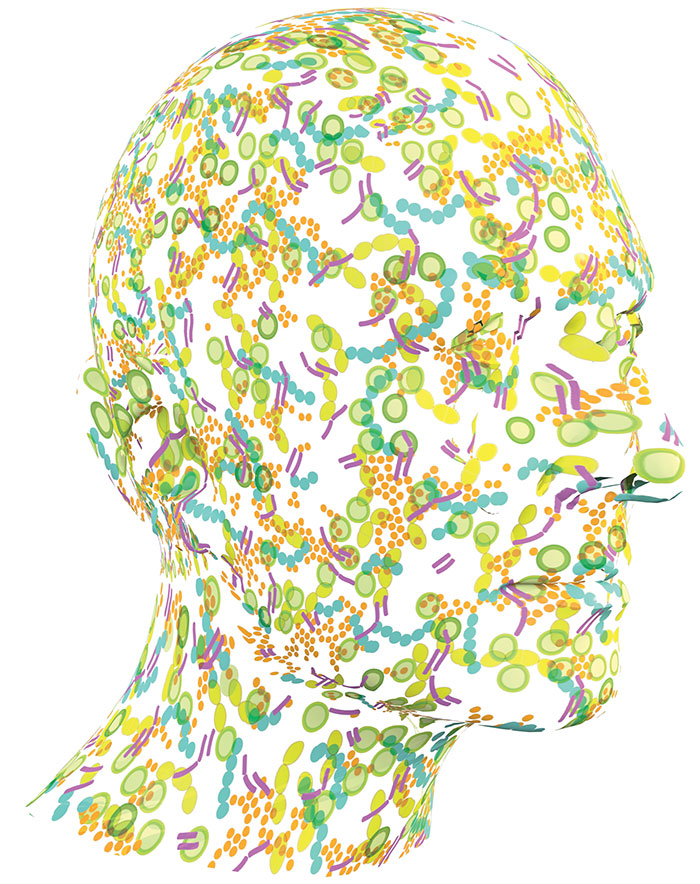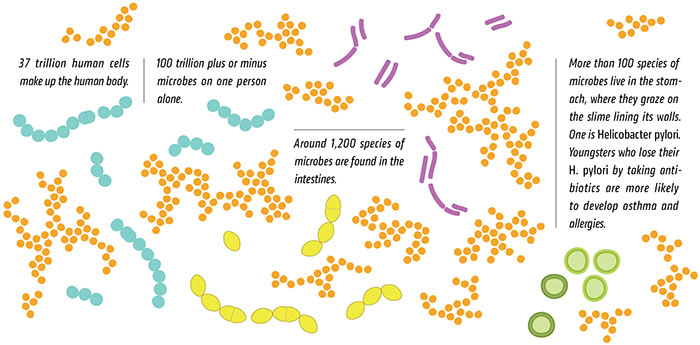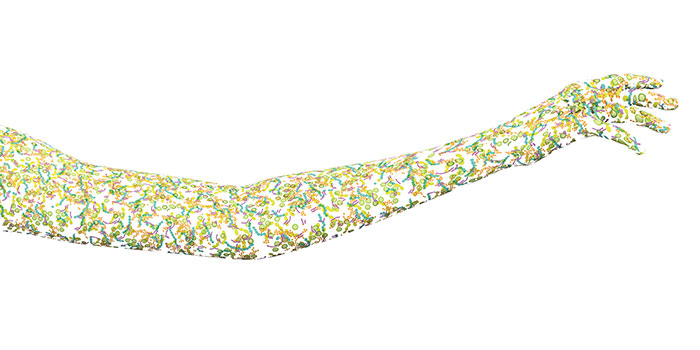
Have you ever felt not completely like yourself? You’re not alone. In fact, you’re never really alone. No matter how hard you may try, you’re always in the company of 100 trillion microbial friends.
Say hello to your microbiome, the thousands of species of bacteria and fungi living in and on you. Biologists now understand that our own cells are just one part of an enormous body ecosystem, and they are just starting to understand how the tiny pieces fit together. The microbiome is turning studies of human biology inside out, changing how doctors treat some diseases, and perhaps even redefining a bit of what it means to be “you.”
In an era of antibiotic-resistant infections, bacteria often get a bad rap, but we wouldn’t be much good without them. Our bodies rely on them in many ways, from helping digest our food and manufacturing essential vitamins in our gut, to training our immune system to fight off foreign invaders. Moreover, our health seems intricately tied to theirs. Disrupted microbiomes have been implicated in conditions ranging from obesity to heart disease.
The idea that our bodies don’t completely belong to us is a relatively new one. It wasn’t until 2013 that scientists undertook the first careful tally of how many human cells make up the average body. That number, about 37 trillion, is at least a hundred times more than the number of stars in our galaxy. Yet, it pales in comparison to the hundreds of trillions of bacteria and fungi we carry around with us.
In some ways, our appreciation of the human microbiome is evidence of a greater shift in microbiology. For decades, microbes were studied in isolation, one species at a time, viewed as nothing more than bags of genes and enzymes for biologists to pick apart. Now, microbiologists have radically shifted their focus from single species to communities. It’s becoming clear that to understand how microbes communicate with us, we need to understand how they communicate with each other.

Communication Breakdown
From his lab on the Forty Acres, microbiologist Marvin Whiteley spends his days listening in on the social lives of bacteria. Much of his lab’s research focuses on decoding the molecular mechanisms of “quorum sensing,” a method of chemical communication common among bacteria.
Bacteria are constantly sniffing out chemical signals in their environment to determine who’s around, and whether they’re friend or foe. These signals can influence behaviors ranging from whether the bacteria should divide or feed to if they release toxins or engage defense mechanisms. Complex populations like the human microbiome are crowded quorum sensing chatrooms, full of chemical conversations among the species that call us home.
The study of human microbes began in 1683, when a Dutchman named Antonie van Leeuwenhoek placed his own tooth scrapings under a crude microscope. There he saw a host of “…little living animalcules, very prettily a-moving.” More than three centuries later, Peter Jorth, a graduate student in Whiteley’s lab, is looking at the mouth’s microbiome through a modern lens to determine how bacteria cause periodontal disease.
We’re used to diseases that act like a cold or the flu. A nasty bug shows up, and we get sick. Getting better simply means getting rid of the unwelcome guest, via medicine or our immune system. But Jorth has found that periodontal disease doesn’t work this way. Essentially the same bacteria are present in a healthy mouth and a diseased mouth. It’s only their behavior that has changed. Those changes are due to some disruption in their environment, but precisely what triggers it, Jorth and Whiteley don’t yet know. What is clear is that our old way of looking at bacterial disease needs an update.
“What we need to know is not who’s there, but what are they doing?” Whiteley says. “That’s where all of this has to go.”

Gut Feeling
Most microbiome research today takes looks past the mouth, into our digestive system. The gut microbiome, swimming around at the center of the body, is quickly becoming the center of human health research. Our guts harbor species like Heliobacter pylori, whose imbalance can lead to esophogeal cancer, and Escherichia coli, perhaps the best-understood organism on Earth, and which gets its very name from the colon it calls home. They haven’t always called you home, though.
You were born essentially sterile, but that changed quickly. On your way out of the birth canal, your intestines were seeded with their first bacteria, some of the same species that you would soon need to digest your mother’s milk. It is known that children born by C-section are seeded with different bacteria, but whether this has long-term effects isn’t understood.
Your microbiome continued to develop as you nursed, with gut bacteria installing a protective coating on your intestines while your immune system developed. Along with every dirty thumb and dog lick came more microbes, until you became the ecosystem you are today.
And just as you aren’t the same person you were when you were young, your microbiome hasn’t remained static. Changes in the gut microbiome can have serious implications for your health.
This year, scientists from Washington University in St. Louis found that mice put on weight when they were “seeded” with the gut microbiome of obese humans, while mice that received “lean” microbiomes stayed thin. And a Swedish team found that particular microbiome populations were linked to type II diabetes, although they weren’t able to establish a specific cause.
Of course it’s not all bad news. In 2010, scientists found that the Japanese had adopted the ability to digest special sugars in seaweed from bacteria that live on nori, the green stuff used to wrap sushi. And in recent years, as more bacteria gain resistance to commonly used antibiotics, many infections have become harder, if not impossible to treat. The Food and Drug Administration recently approved a revolutionary treatment for antibiotic-resistant Clostridium difficile infections, which can cause life-threatening diarrhea, in which the microbiome of a healthy individual is transplanted directly into the infected patient’s gut.
While this doesn’t mean that the cure for diabetes or obesity is as simple as a pill filled with a few million bacteria, it redefines what it means to treat the “whole patient.” Just as changes in our microbiome can spell trouble, doctors are learning that our resident bacteria can be manipulated for our benefit. “The adaptability of the human is really based on the bugs,” Whiteley explains.
The lessons we’re learning from the human microbiome sound a lot like a Beatles lyric: We get by with help from our little friends.
Article written by Joe Hanson (Ph.D. ’13), who blogs smartly at “It’s Okay to be Smart”. Check out his PBS video series at: youtube.com/itsokaytobesmart.
Illustrations by Jenna Luecke and Marianna Grenadier.


















Comments 3
Article on micro biome well written and informative. I learned. Proofing text 4-5 times can really payoff. Keep up the good work.
Microbiome article well done. I learned important info and concepts. New subscriber and will forward this to others. Thanks.
I've known for a few years that bacteria communicate with each other. It just isn't common knowledge. This is a great article to educate the general public.